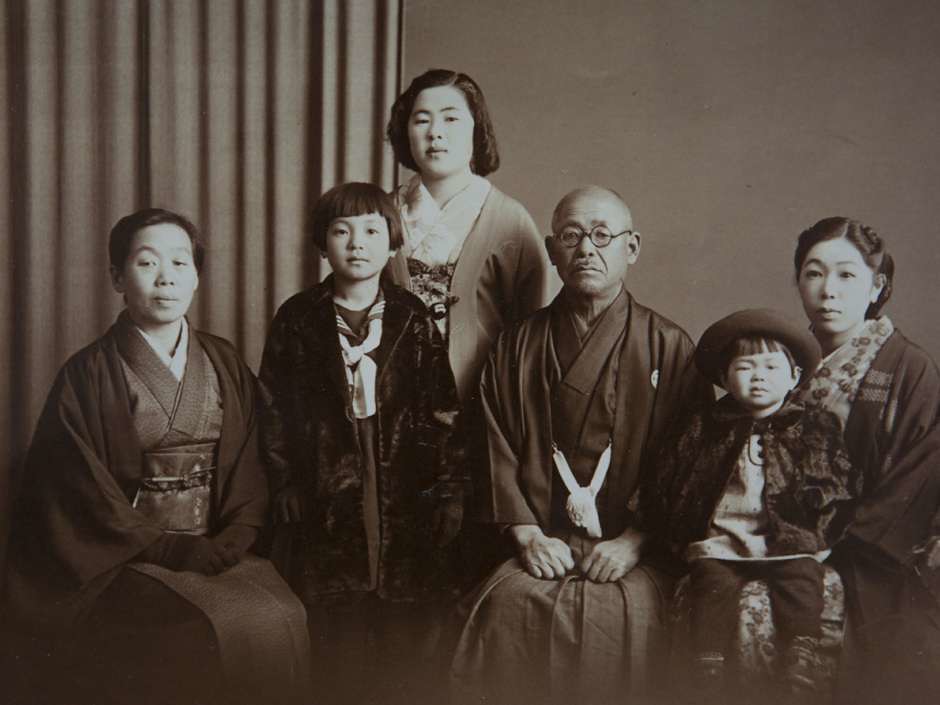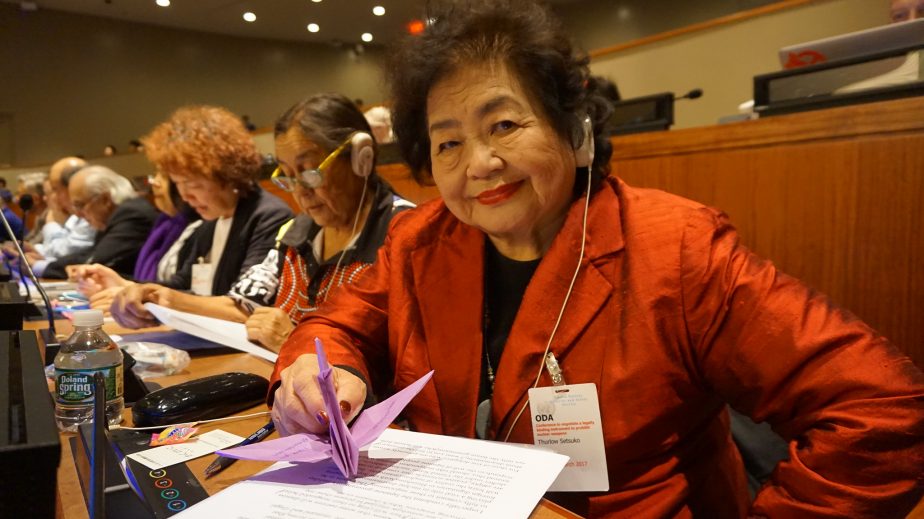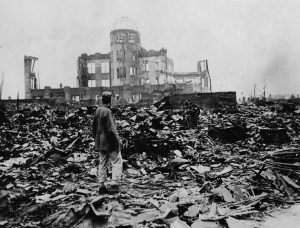It was early August, the hottest time of year, when the ginkgo and plane trees were filled with screaming cicadas, piercing the morning heat like a siren. Benkichi Nakamura, then in his early 60s, was retired and all but one of his seven children had grown up and left home.
Early that fine summer day, before the heat became unbearable, Benkichi set out to sea in his small boat. Even on a Monday morning, there were fish to be caught.
Meanwhile, back in the city, Benkichi’s youngest child, 13-year-old Setsuko, like many children that summer, was out of school. The war was going badly and some students had been recruited to help plant rice. Other children were tasked with sewing military uniforms. Then there was Setsuko, a precocious, observant girl who had been selected to lead her classmates with a job that was, admittedly, far more urgent than would normally be given to teenagers: help the army decode secret messages.
After three weeks of training, Setsuko and her friends were summoned to the second floor of a wooden army headquarters building where Major Yanai gave them a pep talk.
“You girls received good training. This is the first day that you will demonstrate your loyalty to the emperor. Do your best.”
Just as the girls replied in unison, “Yes, sir! We will,” a blinding blue-white flash flooded the window.
Setsuko recalls being blown into the air, her body floating. The tremendous shock of the blast left her unconscious and buried beneath debris. She awoke, pinned by shattered pieces of the collapsed building and unable to move in the darkness.
Soon the silence was broken by the faint voices of other trapped girls crying out, “God help me. Mother help me…”
Setsuko suddenly felt a strong hand on her shoulder and from the darkness came a voice: “I am trying to free you. Don’t give up.”
The voice directed Setsuko to crawl quickly toward a light visible from an opening, allowing her to escape the flattened building just as it burst into flames.
What had been a bright summer morning was transformed into a vision of hell. Cloaked in a foul veil of smoke, soot, and dust, Setsuko saw dark objects moving but couldn’t believe her eyes. Blackened ghost-like figures wandered around her. Some carried parts of their own bodies — sheets of flesh, dislodged eyes, bleeding with blackened, swollen faces and hair standing up on end.
Only a short time earlier, afloat in his fishing boat on the bay, Benkichi never saw the B-29 flying overhead; he didn’t hear its deadly payload fall. But when a strange, terrible mushroom-shaped cloud rose over the city, he knew something awful had happened. After returning to shore, Benkichi made his way — first by train, then by foot — through the devastation to where his home had stood hours earlier.
That morning, August 6, 1945, the United States detonated an atomic bomb for only the second time. Three weeks earlier the Trinity test, conducted in New Mexico, marked the first successful detonation of a nuclear device. The second detonation was no test.
A 15 kiloton uranium bomb, codenamed “Little Boy,” was dropped over Hiroshima. Prior to the attack, residents of the city had grown increasingly unsettled, wondering why Hiroshima, one of the largest cities in Japan, had been ominously spared by merciless bombings that razed scores of other Japanese cities.
Setsuko and her parents were not among the tens of thousands of civilians killed by the bomb dropped that day, but Setsuko’s older sister Ayako and 4-year-old son Eiji, who had returned to Hiroshima for a doctor’s appointment, were.
Three days later, on August 9, a second U.S. nuclear bomb was dropped on the Japanese city of Nagasaki.
Seventy-five years later, speaking from her home in Toronto, Setsuko’s voice shivers with anguish as she describes how two Japanese soldiers doused her sister and nephew’s bodies in gasoline and used bamboo poles to turn them in an open cremation while their family stood frozen, watching numb with shock.

An undated family portrait, sometime before 1945. Setsuko is second from left. Photo provided by Setsuko Thurlow.
Time to Ban the Bomb
In the years since the atomic bombings of Hiroshima and Nagasaki, Setsuko, like many other hibakusha (atomic bomb survivors), has dedicated her life to warning the world of the unimaginable horrors of nuclear weapons.
In July 2017, disarmament proponents achieved a major milestone when the United Nations adopted the Treaty on the Prohibition of Nuclear Weapons (TPNW) with support from 122 nations. Efforts to reach the landmark agreement were led by the International Campaign to Abolish Nuclear Weapons (ICAN).
Setsuko, who campaigned tirelessly in partnership with ICAN, celebrated knowing that after the nuclear weapons ban treaty has been ratified by 50 nations, it will enter into force and the development, testing, production, acquisition, possession, stockpiling, or threatened use of nuclear weapons will become illegal under international law.
Currently, 40 nations have ratified the ban treaty, which is vigorously opposed by the nine nuclear armed states, as well as 30 nuclear endorsing states including Japan and Canada, where Setsuko is a citizen and has resided since marrying Canadian historian Jim Thurlow in 1955.
This year, Setsuko wrote 197 letters to leaders and heads of state of all nations of the world, including a letter to Canadian Prime Minister Justin Trudeau imploring him to acknowledge Canada’s frequently overlooked role in supporting the Manhattan Project while also calling on Canada to ratify the ban treaty.
Setsuko has written to Japanese Prime Minister Shinzo Abe repeatedly but says, “Every time I go to Tokyo, he’s always too busy. Of course he is avoiding me.” The 88-year-old peace activist wonders aloud why the prime minister is afraid to meet her. “I don’t have anything scary but the truth.”
When Setsuko hears diplomats and policy experts discuss nuclear strategy and deterrence theory, she wishes they would instead think of Eiji, her 4-year-old nephew killed by the bomb who, she says, represents all the innocent children that could be killed if any of the world’s more than 13,000 nuclear weapons were used.
The abolition of nuclear weapons, Setsuko argues, “is much too important just to leave it to the politicians. We are talking about life and death issues.”
Under Abe, Japan has had a muted response to U.S. withdrawals from international arms treaties as well as a recent report that the Trump administration was considering the possible resumption of explosive nuclear weapons testing.
Japan’s “chummy” relationship with the United States, Setsuko says, is indicative of an alliance she calls “total subservience to U.S. policy.” She insists Abe and Japan’s powerful Liberal Democratic Party’s opposition to the ban treaty is out of step with public opinion.
Japanese views of nuclear weapons are, in fact, a mixed bag. An April 2019 assessment of public opinion suggested opposition to nuclear weapons may be more conditional than has been previously recognized. In a December 2019 NHK public opinion poll, 65.9 percent of respondents said they supported Japan joining the ban treaty with 17.1 percent of respondents opposed to Japan’s participation and another 17 percent unsure.
Not surprisingly, there is overwhelming support for Japan to ratify the ban treaty among hibakusha, and peace activism in Hiroshima and Nagasaki is among the strongest anywhere in Japan.

Setsuko Thurlow in 2017 at the adoption of the Treaty on the Prohibition of Nuclear Weapons (TPNW). Photo courtesy of ICAN/Thea Mjelstad
Global Hibakusha
Professor Robert “Bo” Jacobs is a nuclear technology and radiation technopolitics historian at the Graduate School of Peace Studies at Hiroshima City University where he has taught for 14 years. For the last decade he has been working on the Global Hibakusha Project focused on communities around the world that have been exposed to radiation. Central to the project is the denationalization of nuclear histories whether in Japan, the Pacific Islands, Central Asia, or downwinders and others who live near nuclear production sites or have been exposed to nuclear testing or accidents.
Jacobs, a U.S. citizen, is blunt in his assessment of the bombings of Hiroshima and Nagasaki. “I think it’s good for us, as Americans, to realize that our country committed war crimes… specifically, we attacked civilians… One of the reasons we used these weapons was to assess their impact. One of the things we wanted to know was the lethality.”
For more than half a century, in its pursuit of nuclear and military superiority, the United States prioritized weapons production at the expense of its own wellbeing, Jacobs says. The insecurity Americans live with today is part of what Jacobs calls the “wreckage of the choices” made during the Cold War.
Observing his home country from Hiroshima, Jacobs says, “We think we won the Cold War. We don’t have health care. We don’t have secure retirement. We have a crumbling infrastructure. This is called losing.”
The Next Generation
One of Jacobs’ students is Hiroshima native Yuumi Okazaki, whose grandfather survived the atomic bombing. Like Setsuko Thurlow, in the early 1950s Okazaki studied at Hiroshima Jogakuin Girls High School. Today she works at the outreach division of the Hiroshima Peace Memorial Museum, but is currently on a year’s leave to pursue peace studies.
Okazaki watches with regret as the United States withdraws from international arms agreements, increases spending on nuclear weapons, and talks of resuming nuclear testing. She wants to see the U.S. and Russia, which possess around 90 percent of the world’s nuclear weapons, play a leadership role in the abolition of nuclear weapons.
“Many people in nuclear states have seen a photo of a mushroom cloud, but they don’t know what happened under the cloud, what each person experienced and thought about the bombing. I would like them to know about each person’s experience.”
Rather than think solely in terms of politics, security, and diplomacy, she wants to see human lives at the center of nuclear discussions.
Okazaki hopes that when people think about hibakusha, they look beyond atomic survivors in Hiroshima and Nagasaki and consider others who have suffered due to nuclear weapons development, testing, and storage in other parts of the world and recognize the importance of global solidarity.
Rather than remaining under the U.S. nuclear umbrella, Okazaki wants Japan to adopt and ratify the ban treaty and become a leader in the elimination of nuclear weapons.
Setsuko is encouraged by increased youth activism. As hibakusha age into their 70s, 80s, and older, she is hopeful that people in their 20s, 30s, and 40s will see the struggle through to completion.
“Unless they take responsibility, what’s going to happen?” Setsuko asks. “I think it’s a moral imperative to take that responsibility. We are leaving here so take the baton from us.”

































